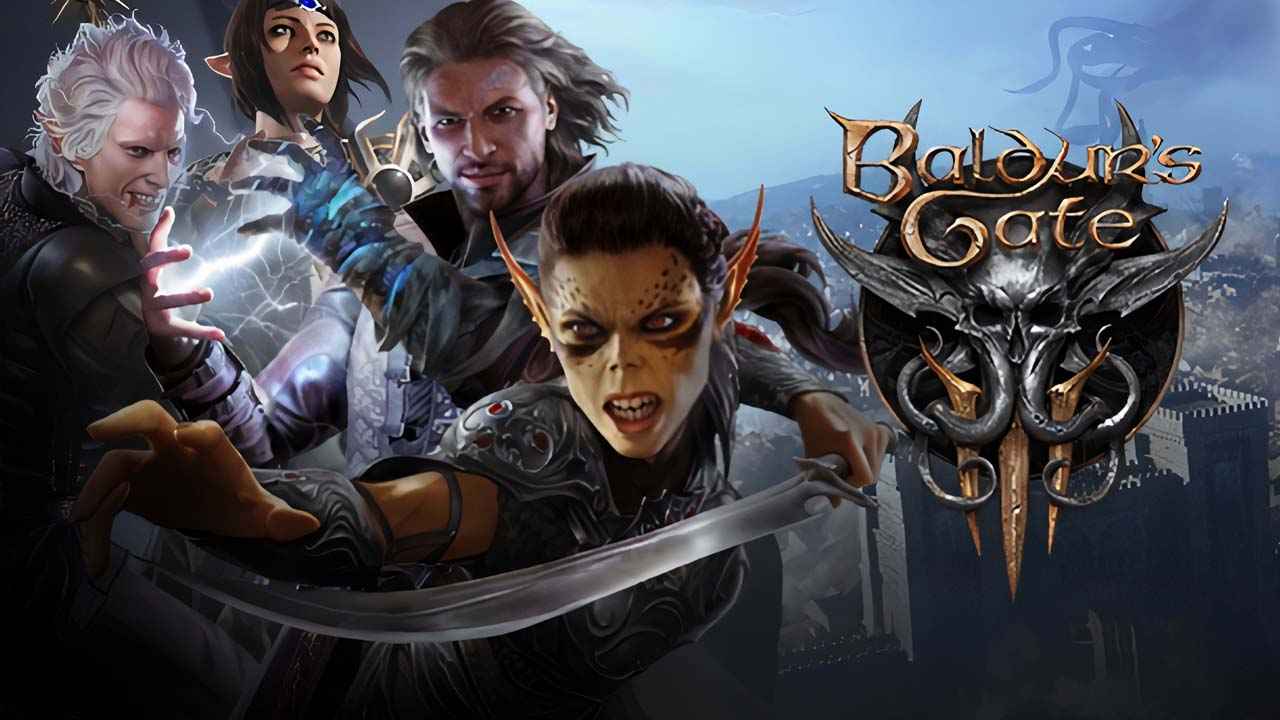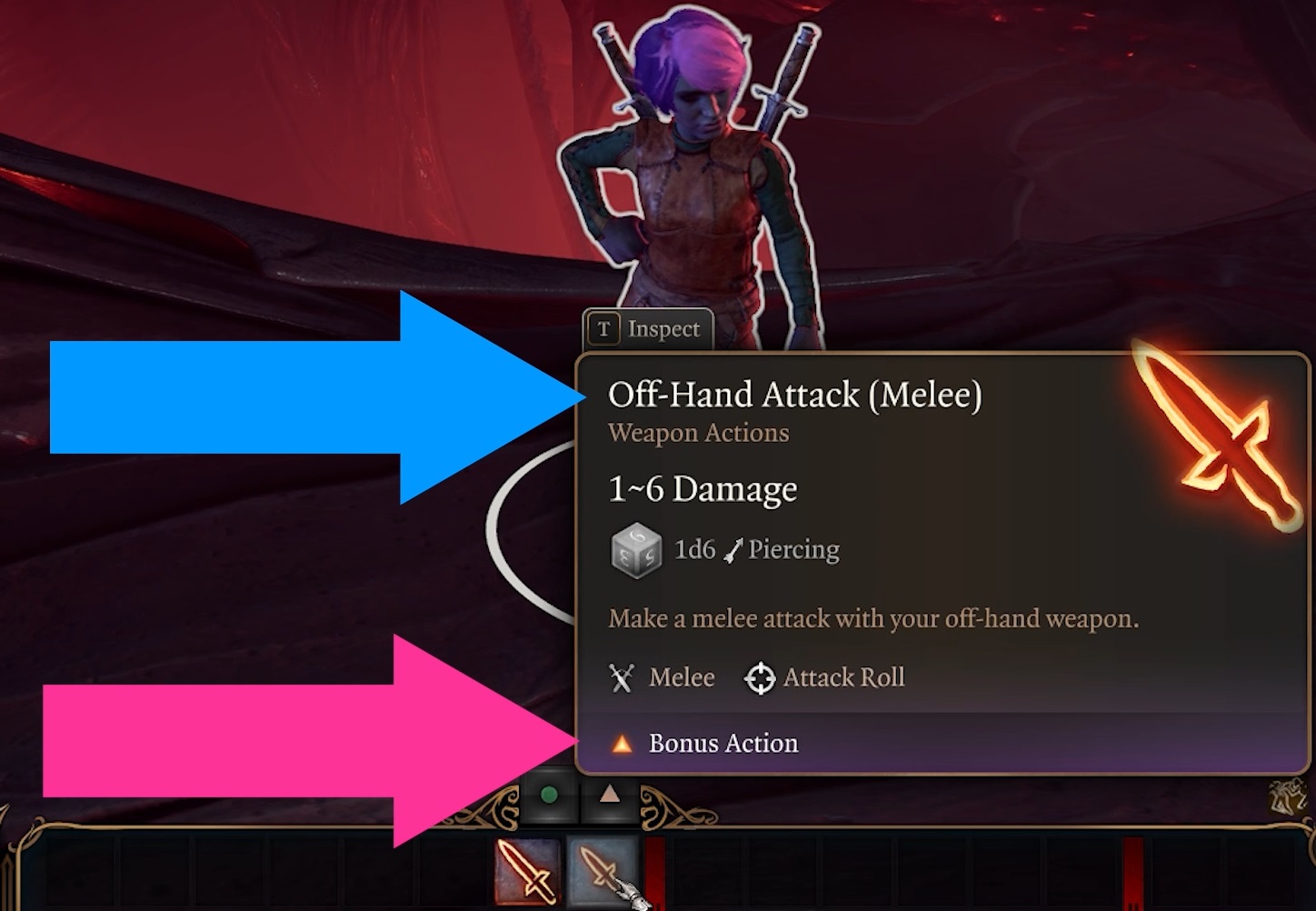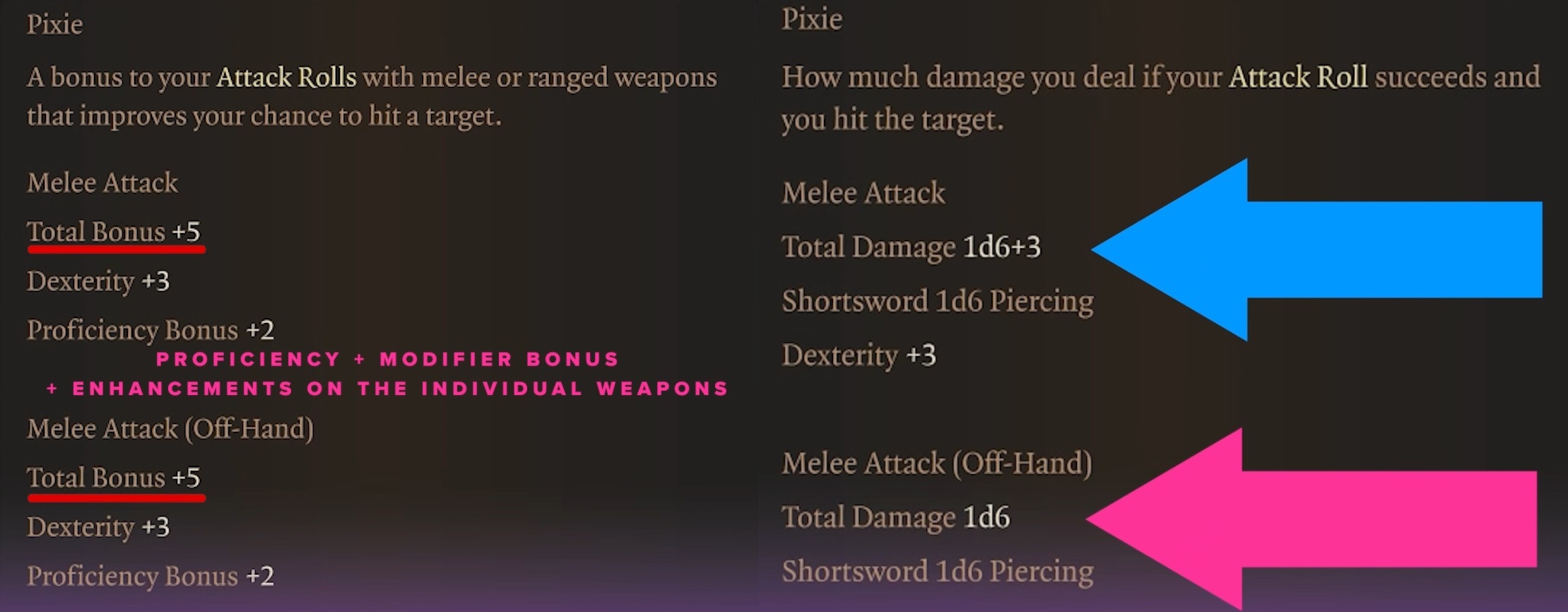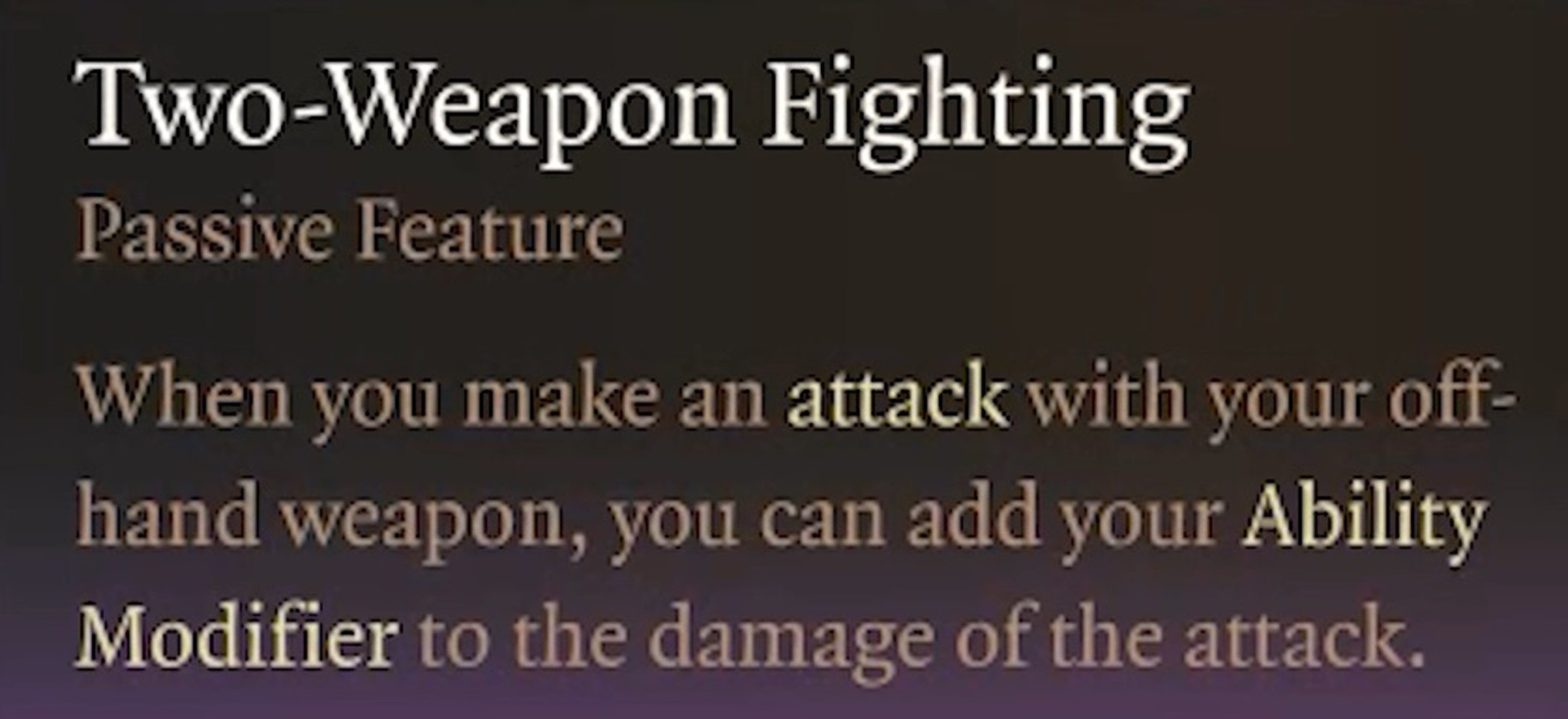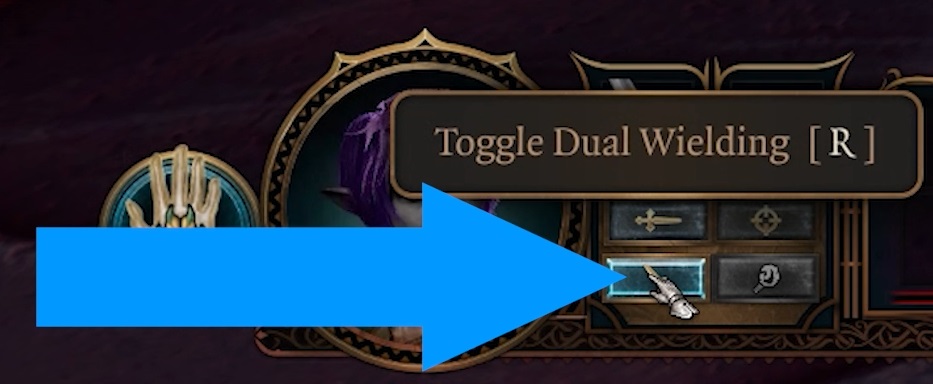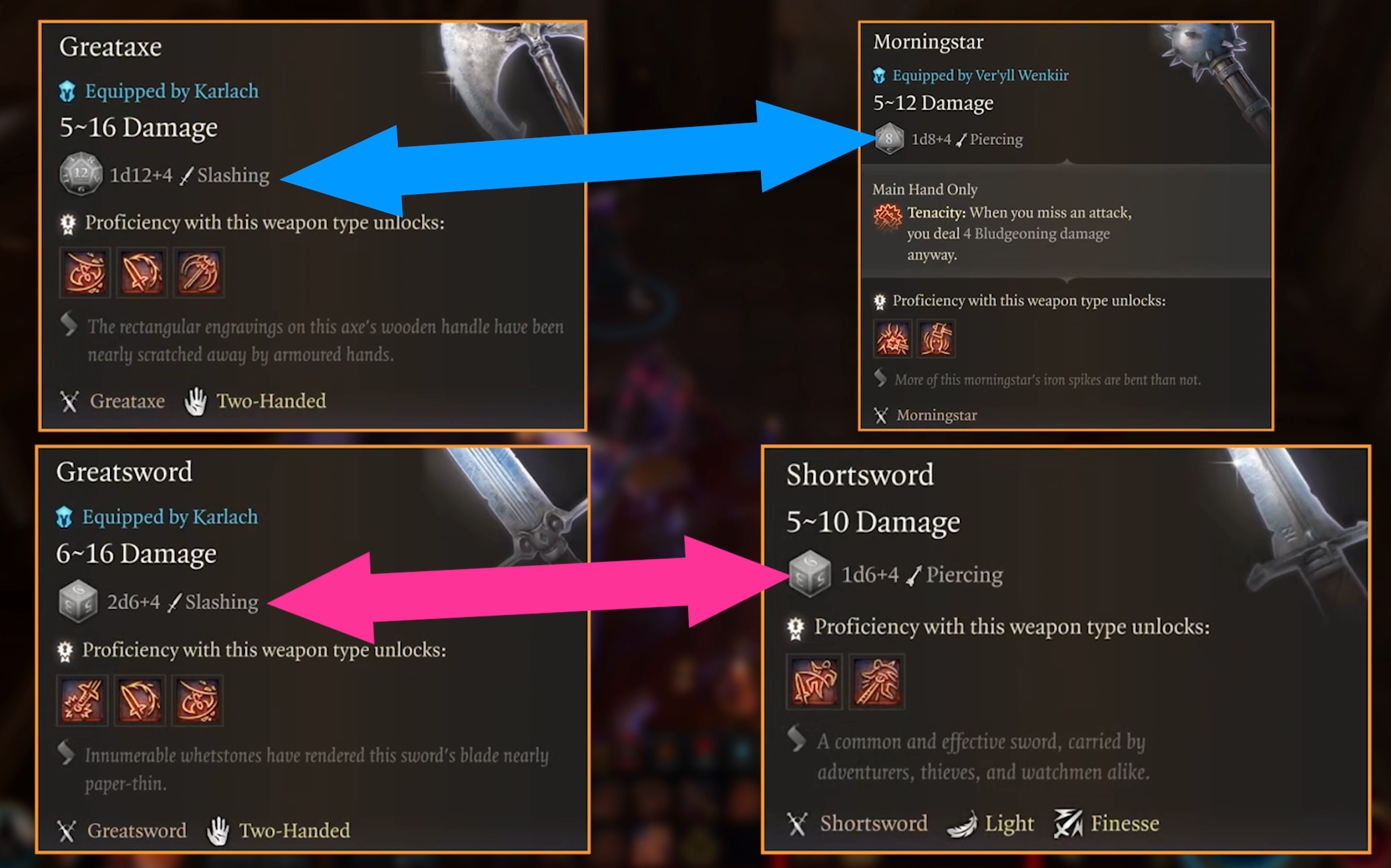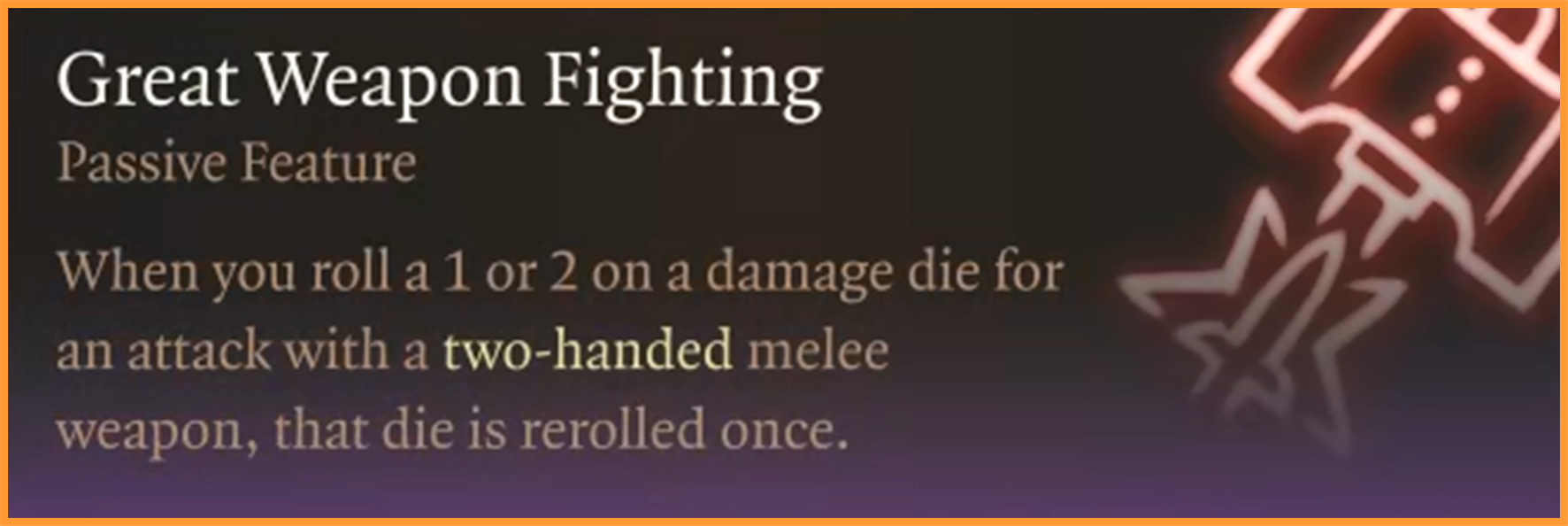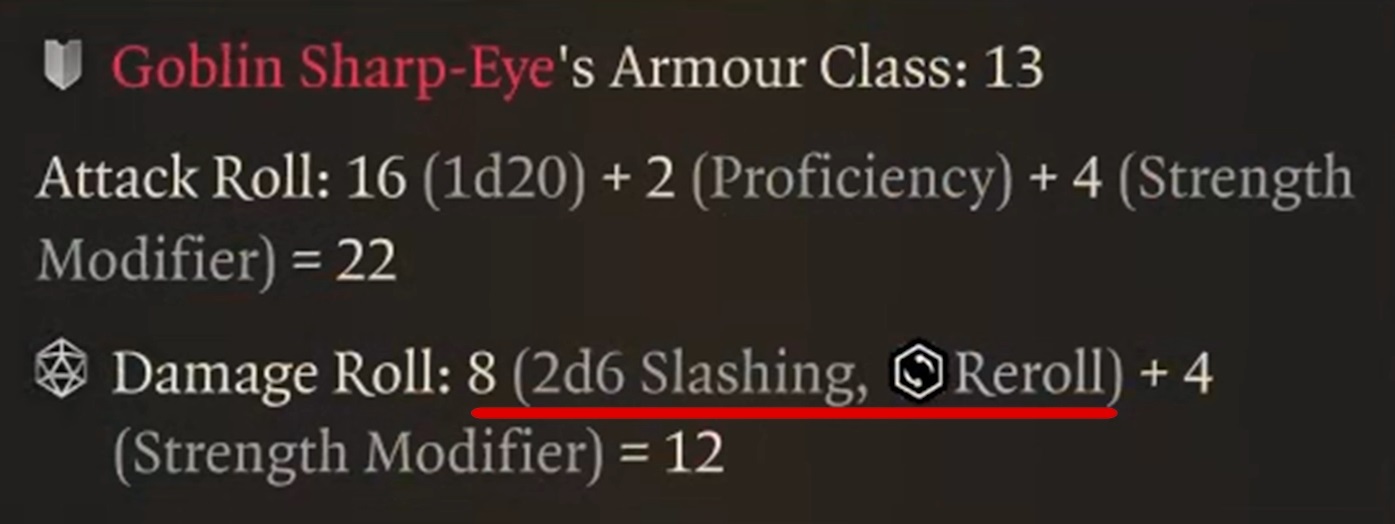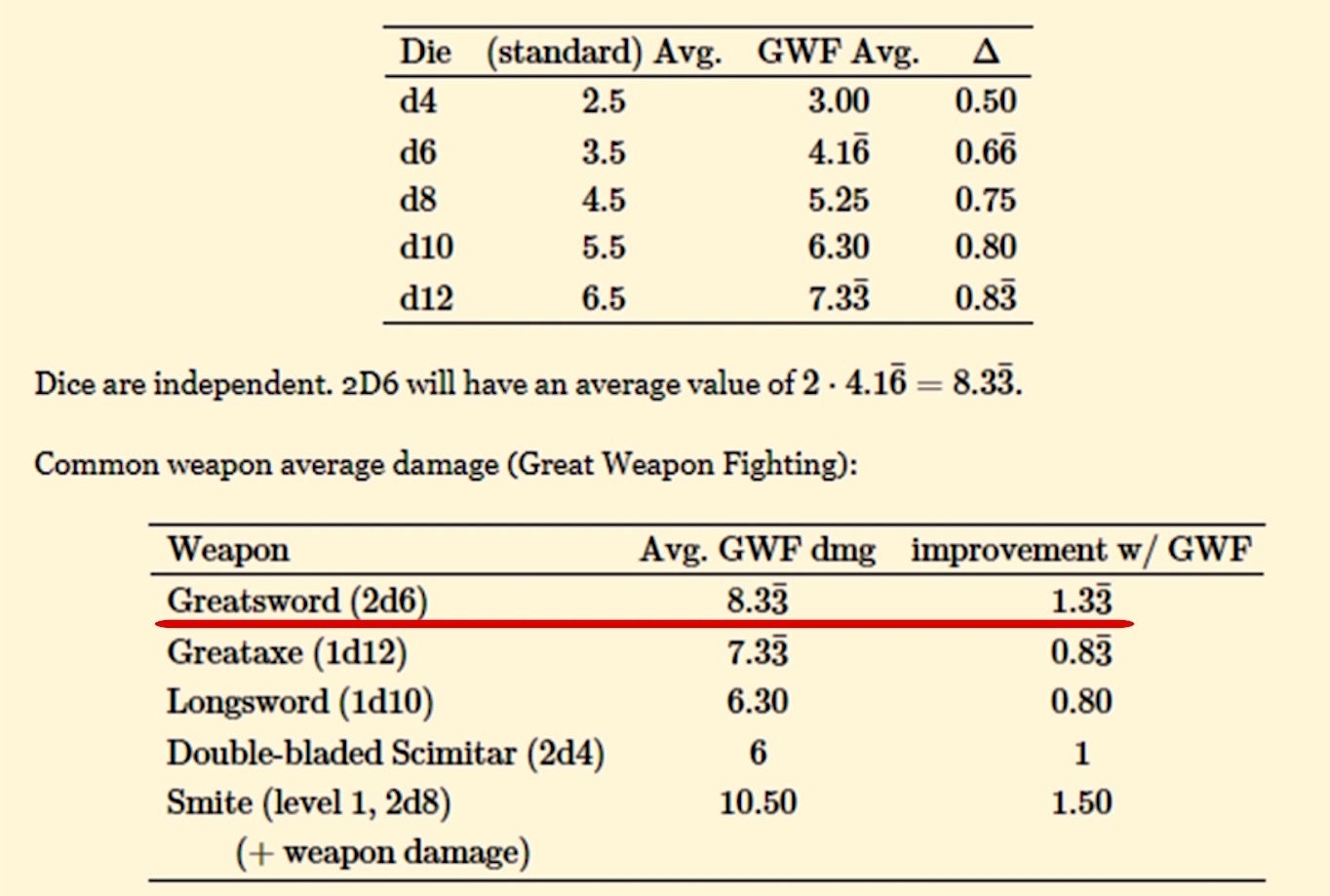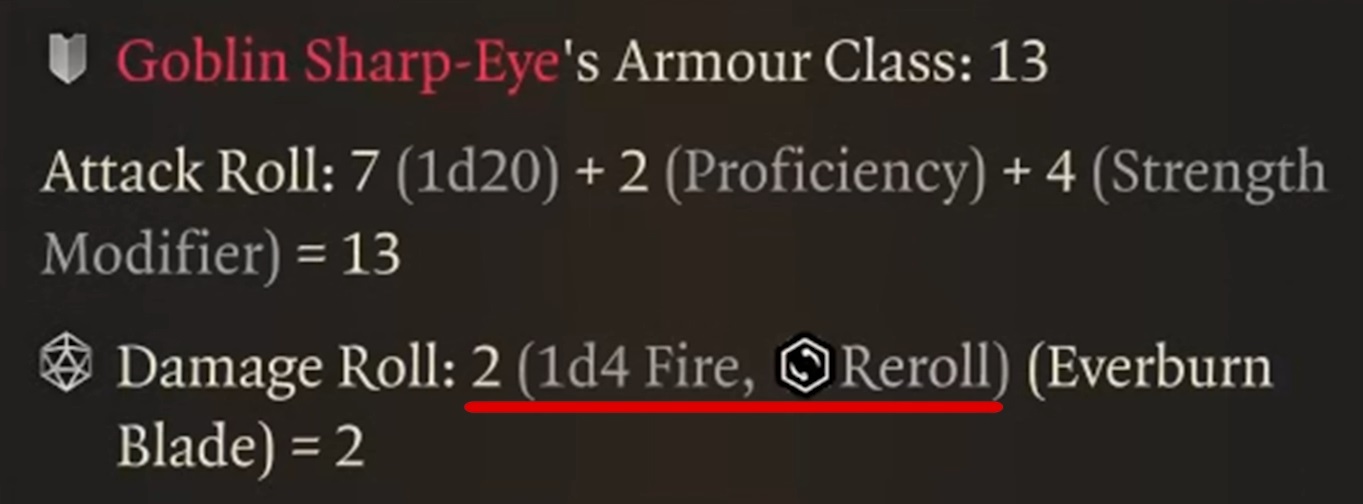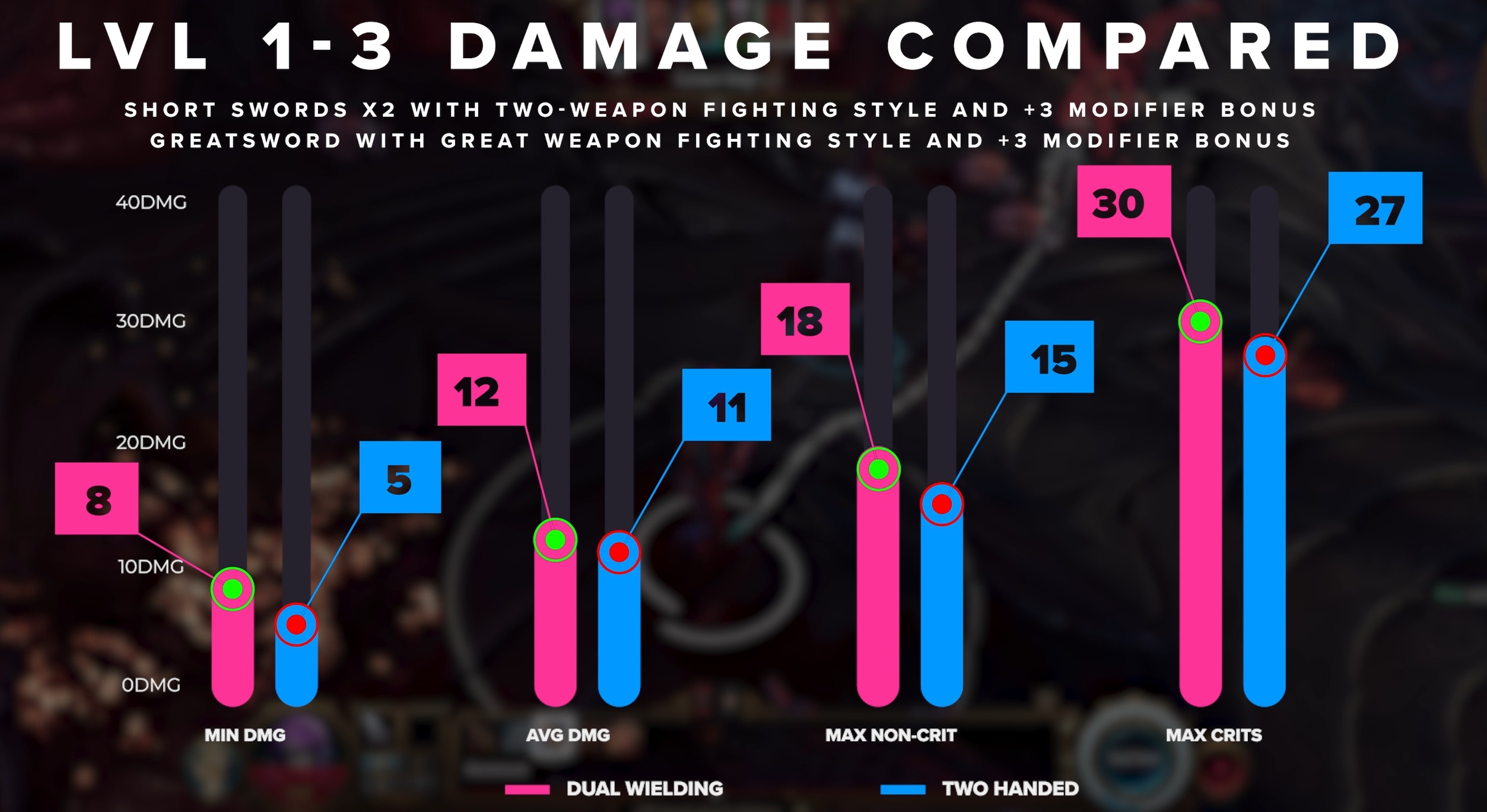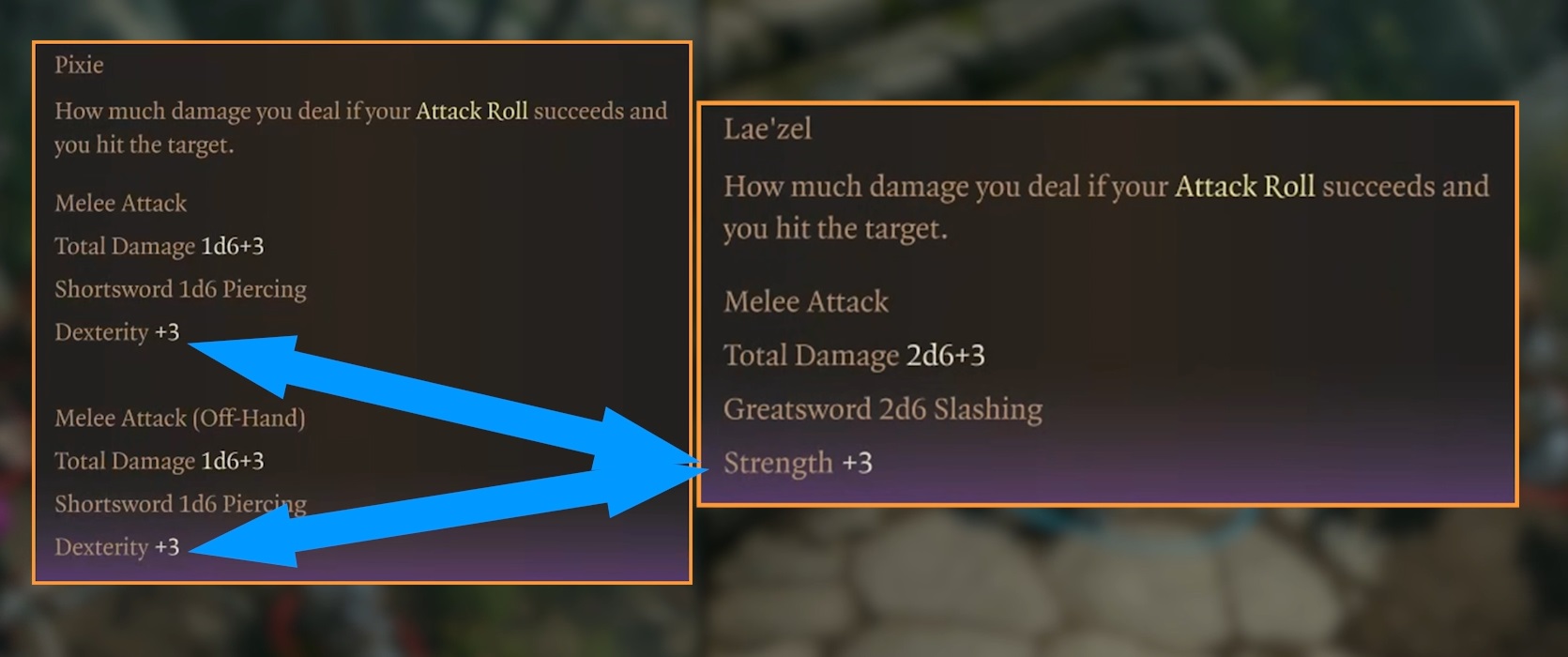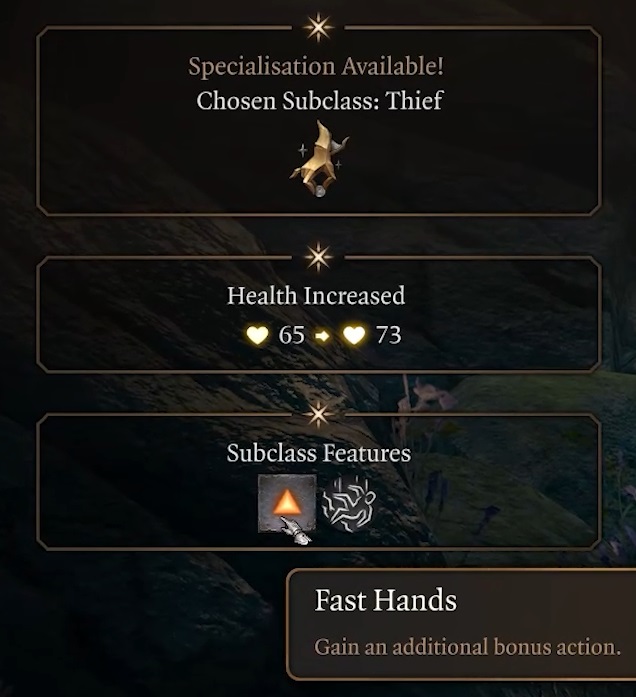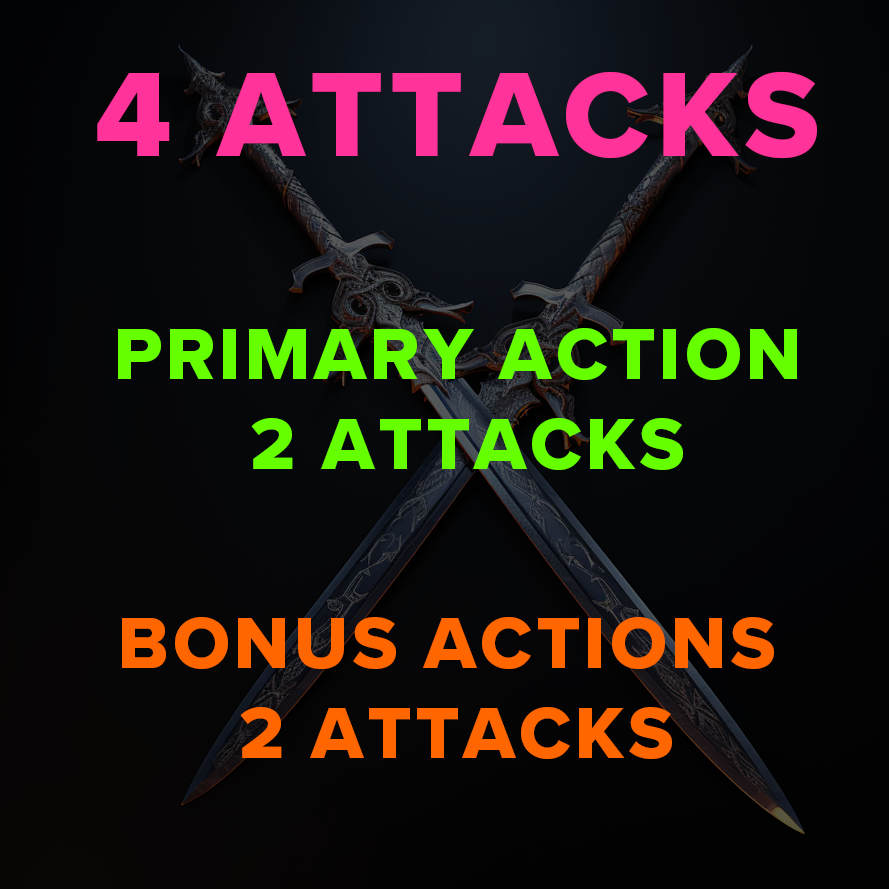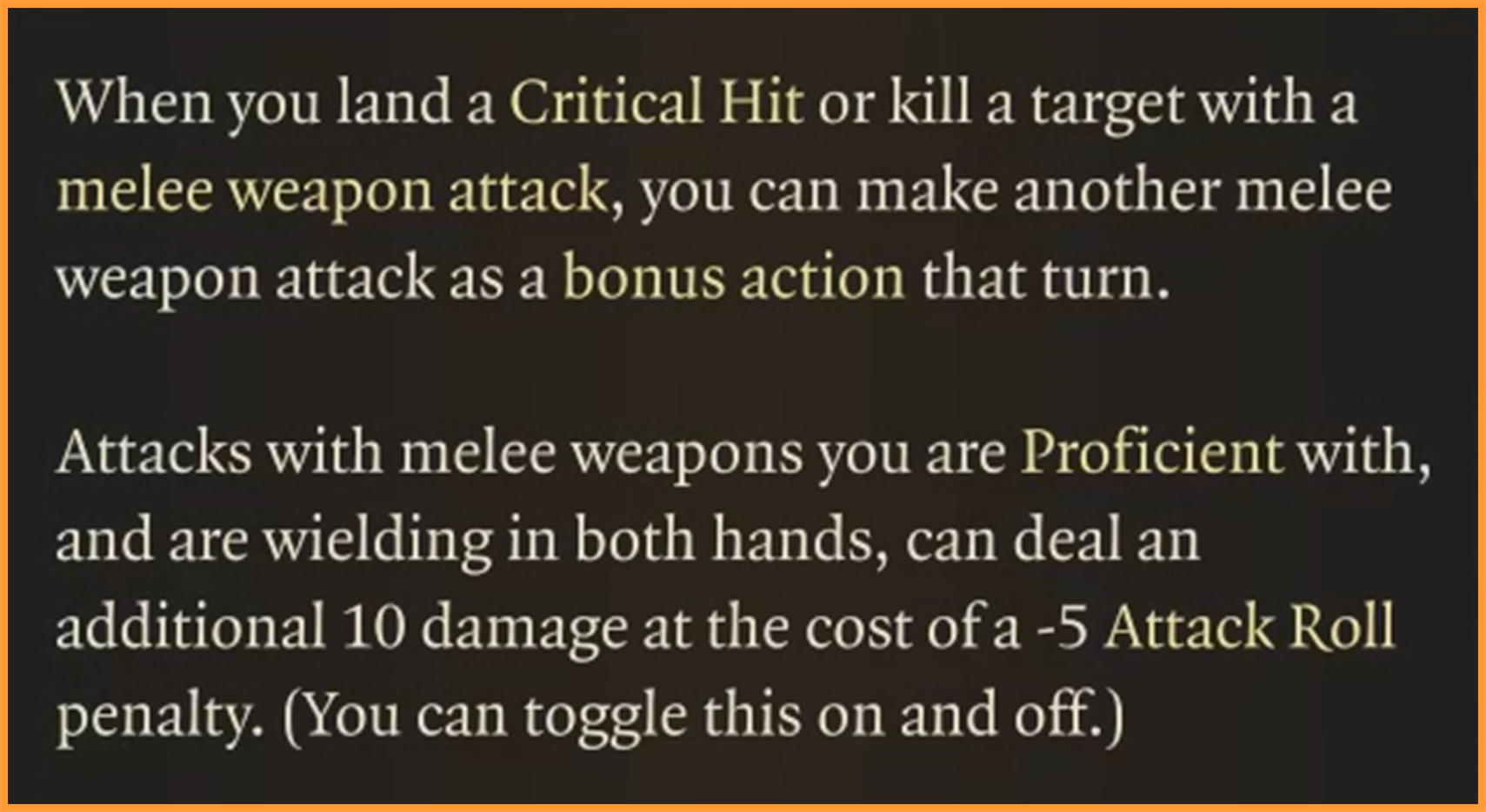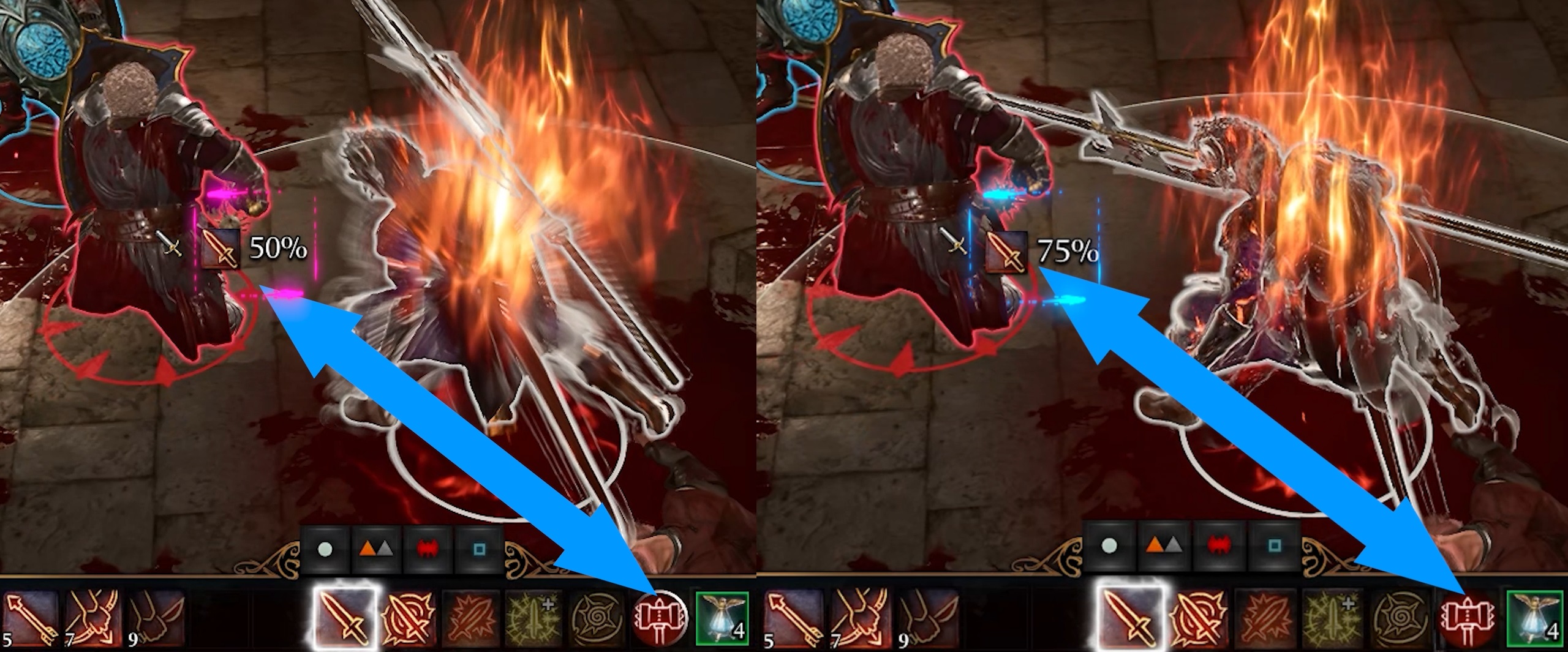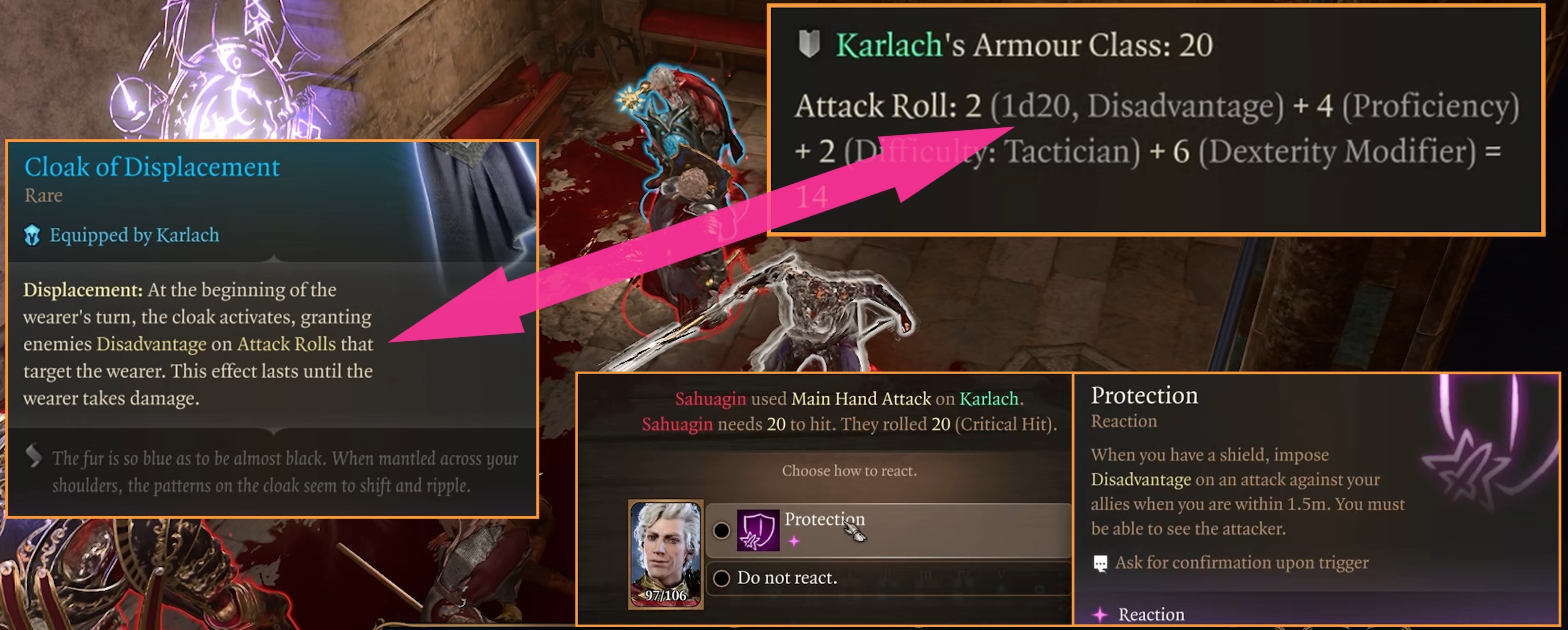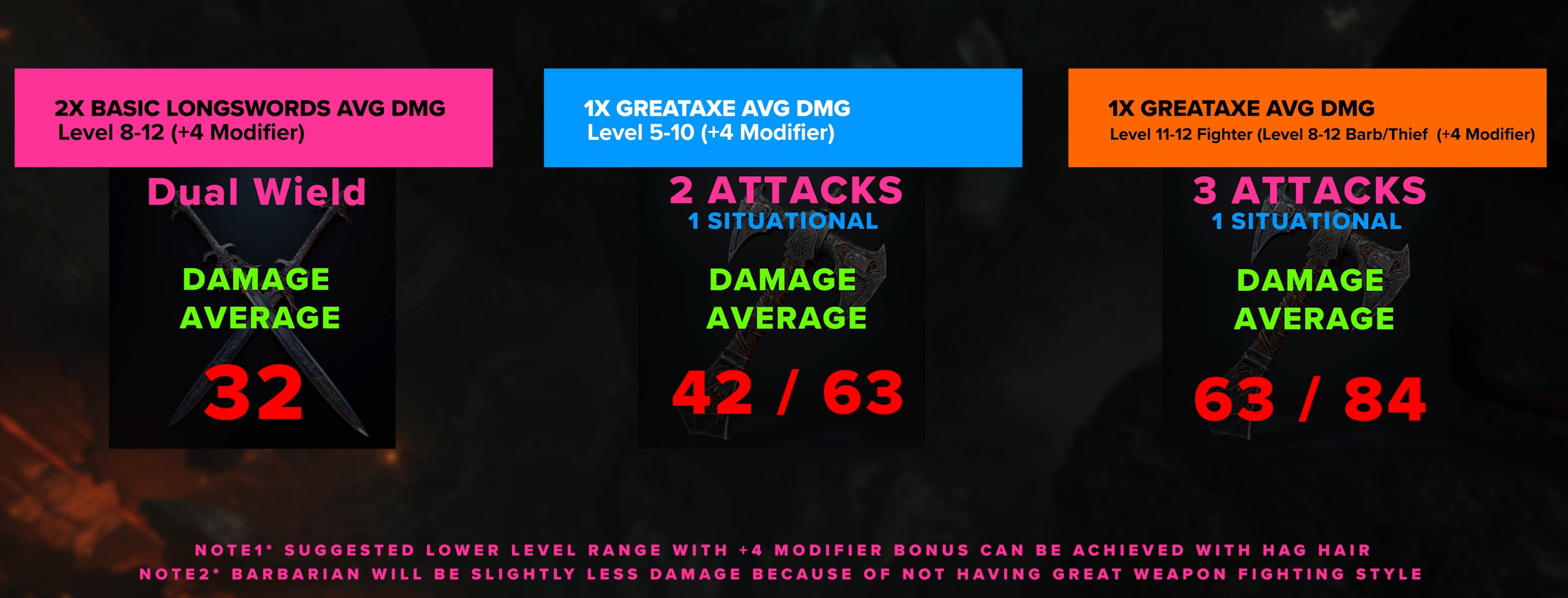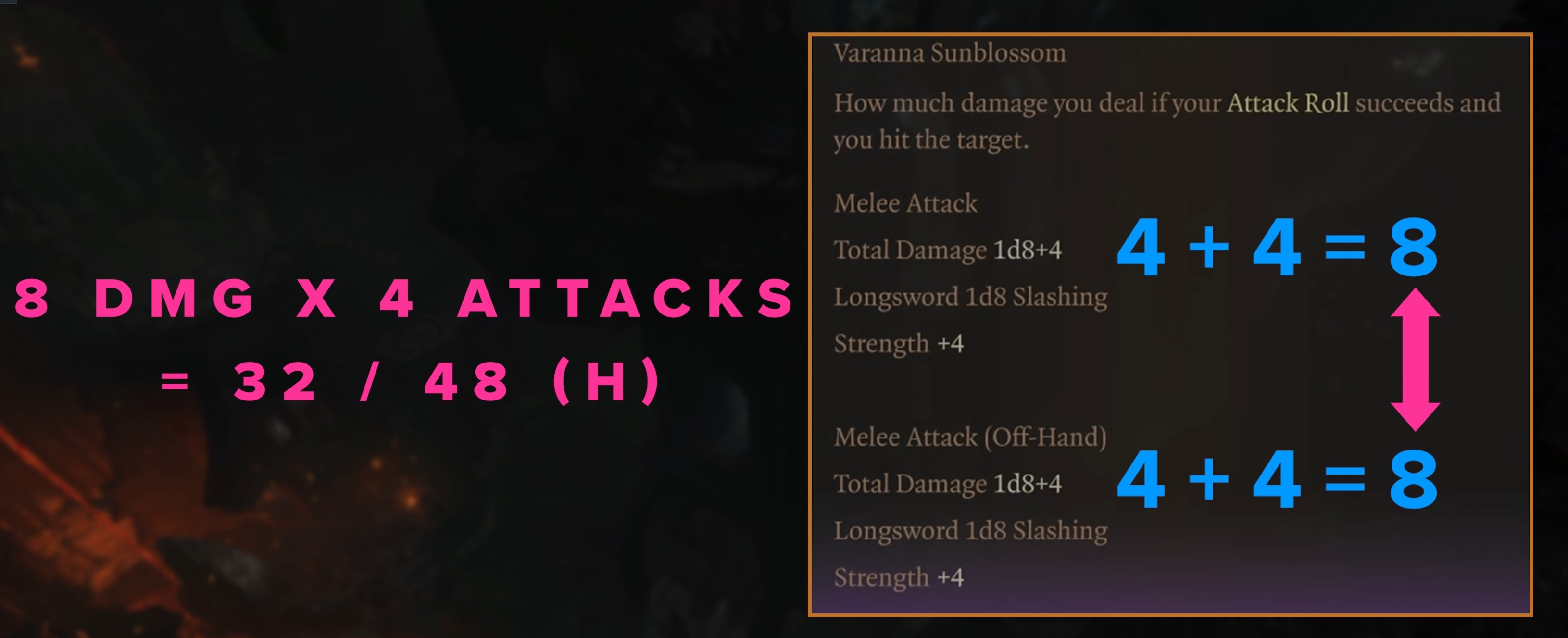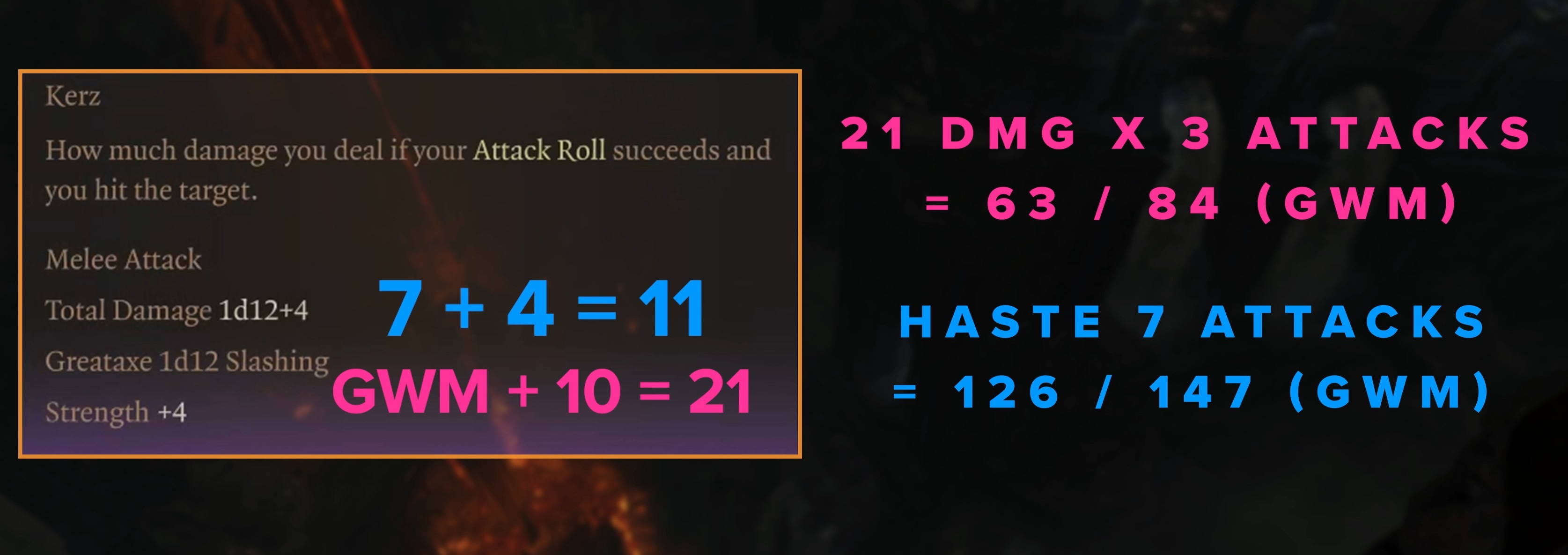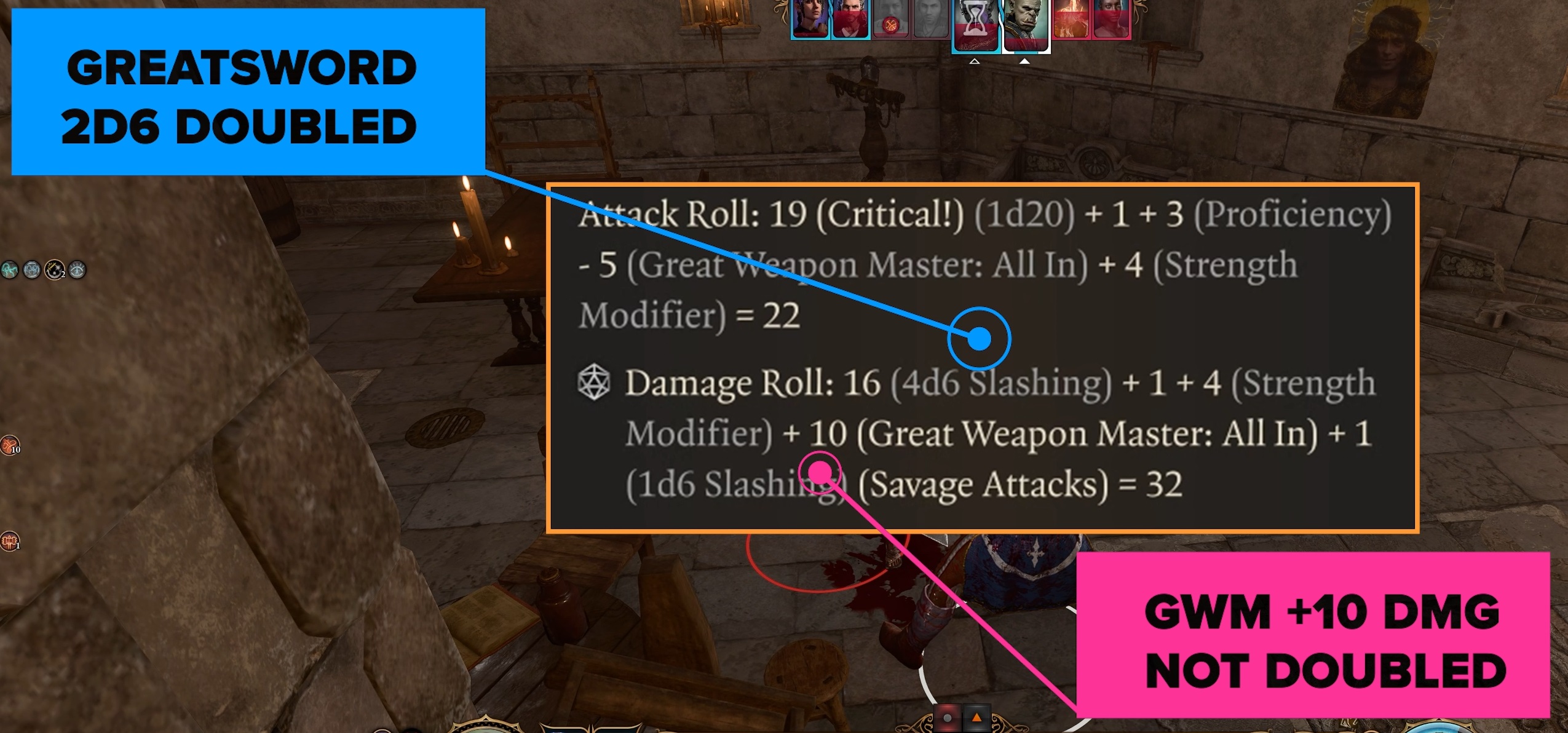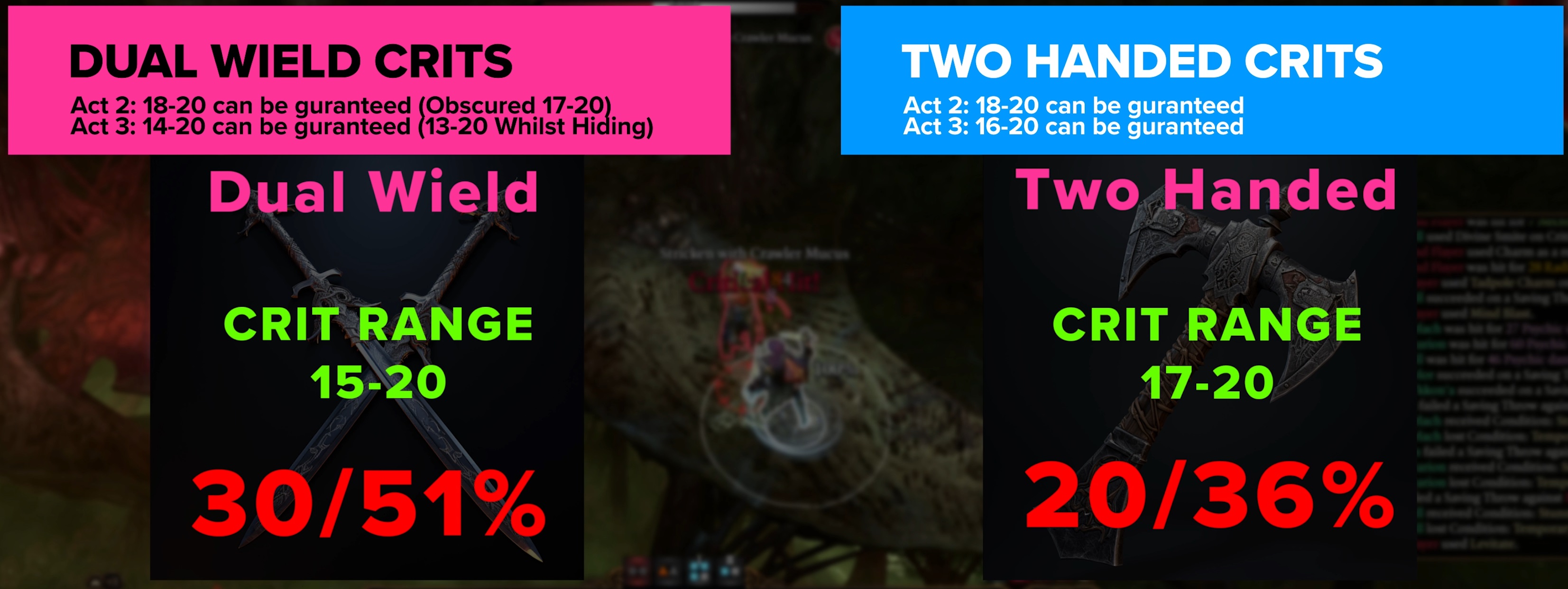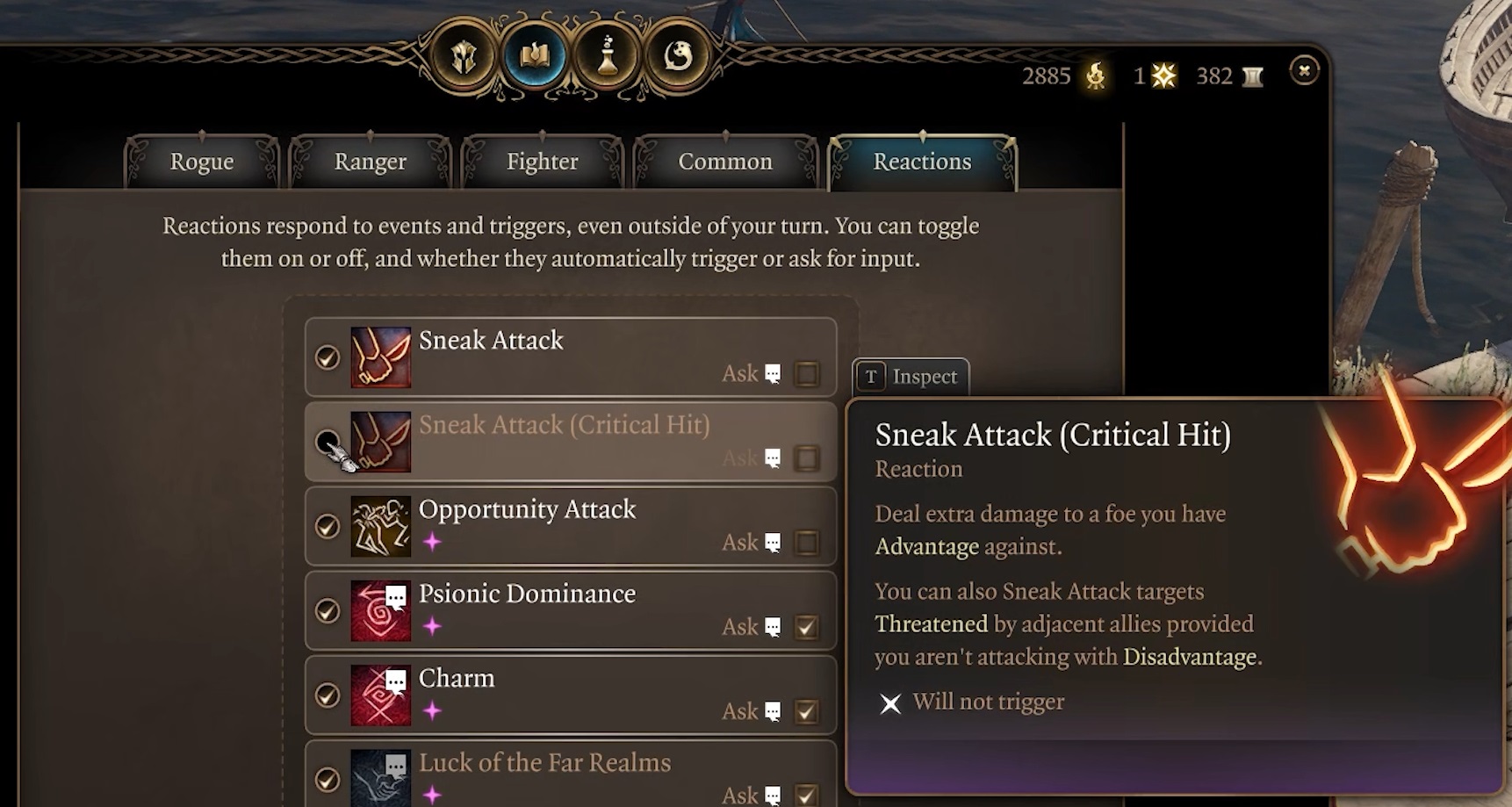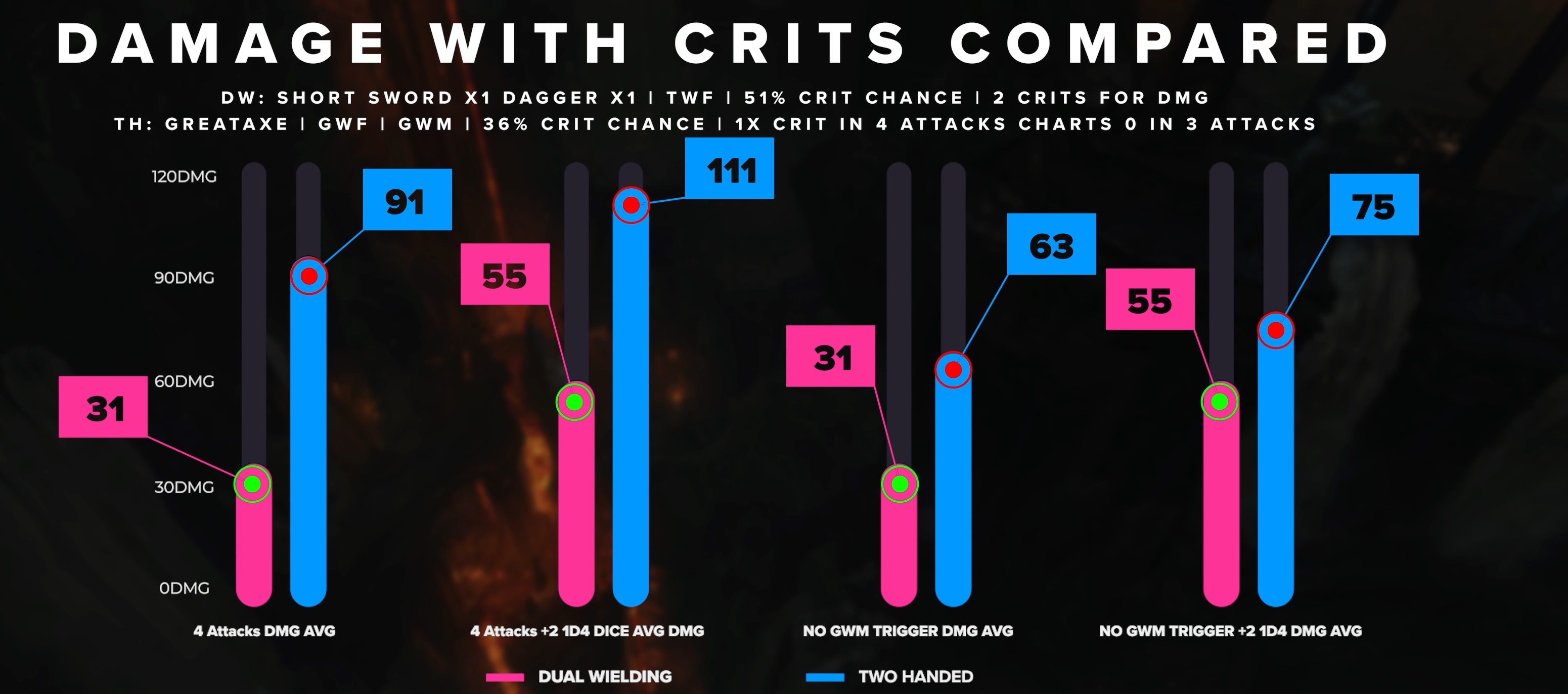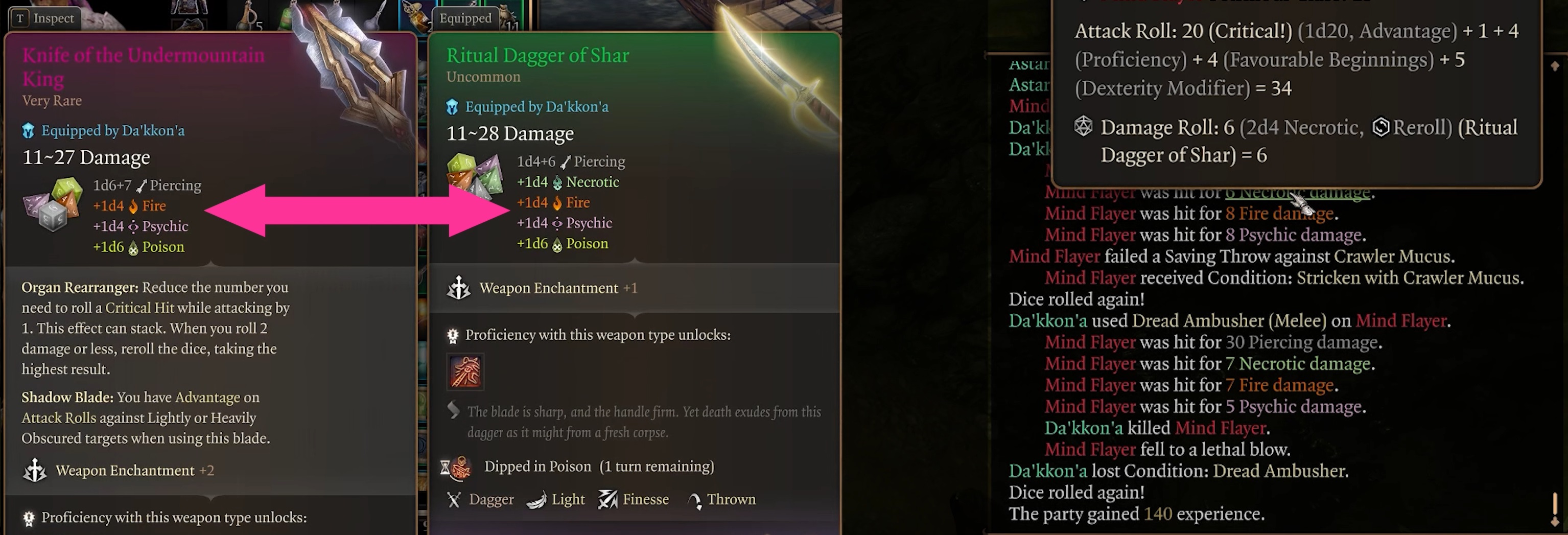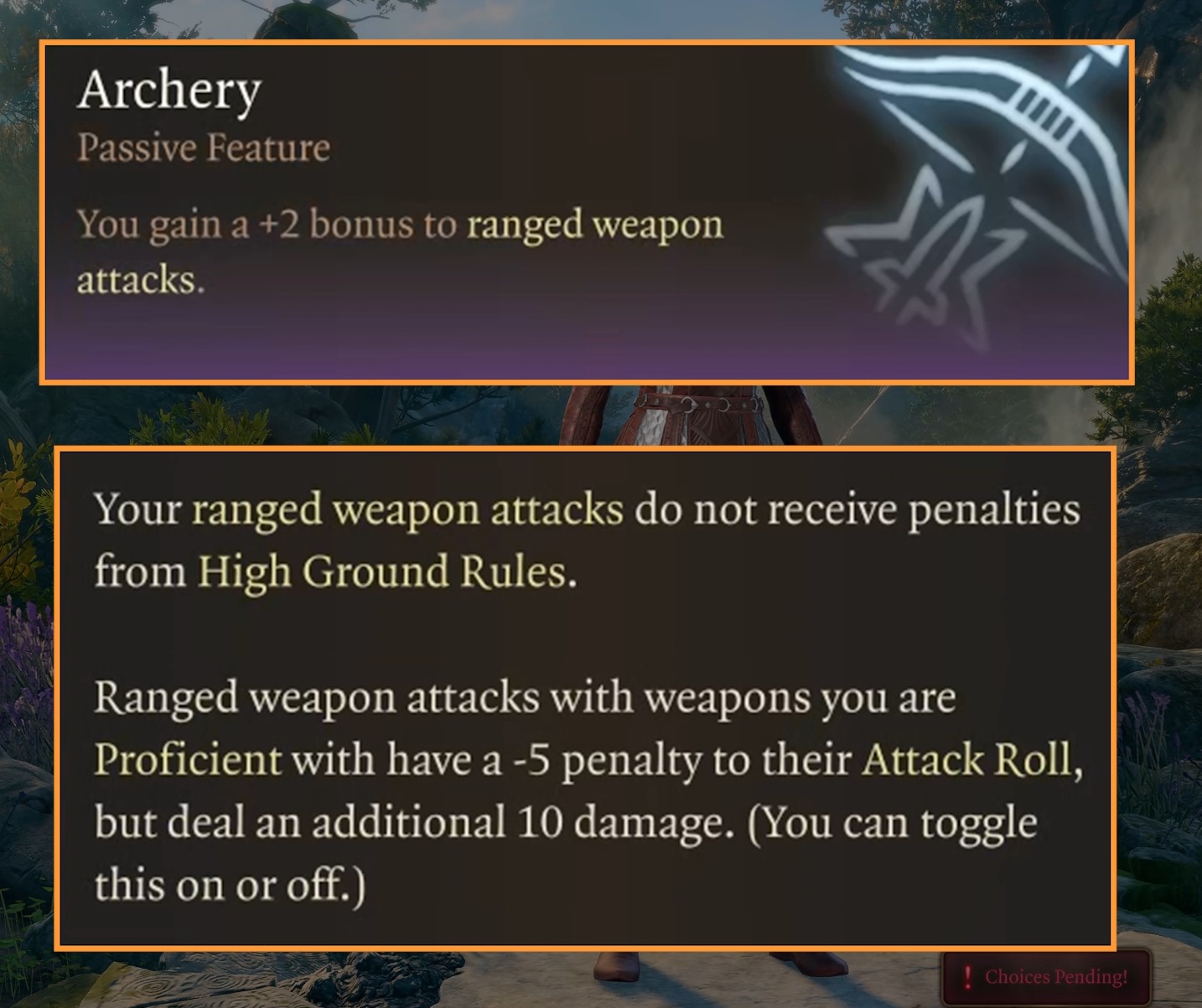Welcome! In this guide I’m analysing Two Weapon Fighting (Dual Wielding) compared to using Two Handed weapons. Breaking down how they work with the Fighting Styles and Feats that can improve them as you level.
Introduction
There is also a fully animated and voiced video of this guide if you prefer to watch rather than read. Or if you have already watched the video, you can use this as a quick reference.
Two-Weapon Fighting Basics
At level 1 and with no feats at all, you can equip two light weapons to your character. Utilising the shield slot as an off-hand weapon.
This Off-hand attack is above and beyond your primary attack action as it uses a Bonus Action instead.
The Off-hand attack will have the exact same chance to hit as your main hand apart from individual weapon enhancements. But it won’t gain your Ability Modifier bonus for damage. You will simply roll the dice for the weapon and that is the damage dealt.
If you have “Two-weapon Fighting”, which is a Fighting Style. You will gain your Modifier bonus damage on that Off-Hand attack, providing better damage consistency.
Fighting Styles can be acquired by level 1 Fighters, Level 2 Paladins and Rangers. Only Fighters and rangers can acquire Two Weapon Fighting though, and one Bard subclass.
If you want to go the Two-Weapon Fighting route, you will likely end up splashing into one of these classes to get Two-Weapon Fighting. And probably a few more levels after that, for the extra attack at level 5 that these classes provide, more on that later.
At low levels, Two-Weapon Fighting, or Dual Wielding as I’m going to call it going forward, can be very helpful for picking off multiple low health enemies. You can effectively split your damage across two attacks, providing some versatility in how damage is dealt.
To do this easier I suggest you toggle Dual Wielding to off, and manually choose where each of your attacks goes.
At low levels you won’t have many Bonus Action options that will be better than taking an additional attack, whether you have the Two-Weapon-Fighting Style or not.
Two-Handed Weapons Basics
Two handed weapons are far easier to understand, you simply roll your damage dice and add your Modifier Bonus.
Two-Handed weapons will have more, or better damage dice though, compared to single handed weapons.
And there is the Fighting Style “Great Weapon Fighting”. Where once again level 1 Fighters and Paladins at level 2 can acquire this.
It provides a more consistent damage output by re-rolling damage dice that land on a 1 or 2.
If you have a Great Sword that deals 2d6 damage and your dice rolled are both 1 or 2, you would re-roll both dice and accept whatever the new roll is.
The benefits are broken down in this great post by AceCalhoon.
A Great Sword on average will be dealing 1.33 more damage, and a Great Axe will deal an additional .83 damage on average according to the maths.
And this benefit goes beyond the weapon base damage, because all dice can be re-rolled, as we can see in this example where the 1d4 bonus fire damage also got a re-roll.
Low Levels Compared
When comparing Dual Wielding and Two-Handed weapons, we can see some interesting results using spreadsheet maths.
A Fighter between level 1 and 3 with 17 Strength, and using a Great Sword with the Great Weapon Fighting Style. Will on a hit, deal 2d6 damage +3 Modifier Bonus to one target.
Which is on Average 8.33 which we will round down for simplicity to 8. +3 for a total of 11 damage to the target.
A level 1-3 Fighter wielding two short swords with 17 Strength or Dexterity, and the Two Weapon Fighting style. Will have two attacks.
The main hand will deal 1d6 which is on average 3.5 again rounding down to 3. We then add +3 for the Modifier Bonus, for a total of 6.
And the Off-Hand will be exactly the same, 6 damage on average.
That is 12 damage across potentially two targets compared to 11 damage to one target.
With the two attacks the Character adds their Modifier bonus twice compared to once for Two-Handed Characters. The Great Weapon Fighting Style with re-rolls, closes the damage average gap a bit.
Keep in mind a Barbarian for example, would not have this Fighting Style, their average would be 10 damage, 2 behind the Dual Wielding Character.
The Character also gets two attacks to deal the damage. If a Two-Handed Weapon Character misses, they deal no damage. But when Dual Wielding, you have a chance to still deal half your damage.
And you have an additional chance to score a critical hit, likely this will only be on a 20, so it’s not a massive boost, but a boost none the less.
At low levels, on average, Dual Wielding deals more damage, has more versatility in how you can output that damage and do it more consistently.
But how does this change as the levels increase?
Dual Wielding at higher levels
Dual Wielding has a few ways it increases in power as your character progresses in levels.
The Duel Wielder Feat will allow you to use larger weapons with a greater damage dice pool such as two Longswords.
And the +1 Armour Class is not to be ignored especially in Honour Mode.
Where things really improve though is by gaining additional Bonus Actions, as these are effectively additional Off-Hand weapon attacks.
The easiest and most consistent way to do this is by taking three levels in Rogue and the Thief subclass. This extra Bonus Action can be an additional attack every round.
At level 8 it’s not hard for a Character to go 5 levels into Ranger, for Two-Weapon-Fighting and the extra attack gained at level 5. With the Feat selected either improving your Ability Modifier bonus (which I recommend), or taking Duel Wielder if you prefer.
You can then have 3 levels in Rogue and the Thief subclass for the additional Bonus Action.
You can also go Fighter and then into Rogue, I recommend going Ranger Gloomstalker as you level though especially, if you are relying on this Character for Sleight of Hand of checks.
Either way, this Character each round will have 2 main hand attacks and 2 Off-Hand attacks with their Bonus Actions.
This is a guaranteed 4 attacks a turn. Or 6 attacks when Hasted.
The Fighter route gains Action Surge for a one-off extra two attacks. The Gloomstalker path with the Ranger provides a free extra attack in round 1 with bonus damage.
And at max level you can re-spec to combine both these options and still get 3 levels in Rogue for the Bonus Action. There are also ways to get more than 2 Bonus actions.
But to keep our comparisons grounded, let’s stick to the basics for now, ignoring all the one-off attacks and situational extras.
The Dual wielding Character in this example, has 4 guaranteed attacks each round. Potentially with two Longswords dealing 1d8 damage each and +1 Armour Class for defence.
Two-Handed Weapons at higher levels
One of the most insane ways Two-Handed Weapons improve is with the Feat Great Weapon Master.
You get -5 to hit which is painful, but you gain a crazy additional 10 damage when the hits land!
This can be toggled on and off helping you to decide when it is worth it or not per target.
The -5 to hit opens up a greater chance for dealing zero damage. This can be mitigated with something like Reckless Attack on the Barbarian, getting Advantage on the attack roll. Or using something like Risky Ring.
Reckless attack impacts the defensive abilities of the Character, providing Advantage to the enemy’s attacks in Honour Mode that can be very dangerous. Although even this can be mitigated somewhat with items or other characters abilities.
Great Weapon Master in addition can provide an extra attack via a Bonus Action on a Critical hit or kill. This is situational but does provide a pretty good chance of triggering and increasing our damage potential with an extra attack.
Damage breakdowns at high level
To determine damage potentials, we must first understand how many attacks the Characters will have.
The Dual Wielding Character in our example will have a guaranteed 4 attacks each round, 2 from the primary attack and 2 from Off-Hand Bonus Actions.
Two-Handed weapon Characters will have two guaranteed attacks with their Primary Action attacks. And a situational third attack as a bonus action, if Great Weapon Fighting triggers.
level 11 Fighters with Improved Extra Attack will have three guaranteed attacks with the potential for 4.
And Barbarians can get an equal equivalent from round 2 in a fight. Using Frenzy strike and if they gain a second Bonus Action such as by splashing into Thief. They can also trigger Great Weapon Fighting for the potential of 4 attacks each round.
In these examples only basic weapons with no bonuses or enhancements will be used and all Characters will have a +4 Modifier bonus for damage scaling, to keep everything nice and simple.
Dual Wielding characters with that feat can at best case use two Longswords for damage.
The average of a D8 is 4.5. Which we will round down to 4. Then add the +4 Modifier bonus on each attack for 8 damage.
The main hand and Off-hand attacks will be the same.
So that is 8 Damage times 4 attacks. 32 damage without Haste. With Haste it’s 48 damage.
The Average damage of a Greataxe with Great Weapon Fighting is 7.33, that we will round down to 7. The same +4 Modifier brings the average to 11, but then we have +10 damage for Great Weapon Master. Totalling 21 damage each hit.
21 damage times 3 attacks is 63 damage or 84 if GWF triggers for an additional attack. With Haste its 126 damage or 147 if Greater Weapon Fighting triggers.
That is a huge difference in damage potentials and Two-Handed weapons appear to wipe the floor with Two Dual Wielding.
But it doesn’t quite tell the whole story.
Consistency and defence
When Dual Wielding you have more consistency. Your damage output potential is lower, but it is more consistent.
The 4 attacks are almost guaranteed each time, unless you must jump or drink a potion for example.
Attacks are more likely to hit as you don’t have the -5 to hit and increased chance to miss, dealing no damage.
You gain +1 Armour Class which is handy, especially if the Two-Handed character is relying on something like Reckless Attack to overcome the negative hit chance.
+1 Armour Class compared to providing Advantage to enemies is a big swing in whether you are going to be hit or not.
Two-Handed Weapon characters replace those benefits with the potential for a huge amount of raw damage instead. Knocking enemies out of the fight faster and therefore saving damage by reducing the amount of attack actions the enemies can throw at you.
But there is another benefit for Duel Welding, you get more bonuses and abilities on those equipped weapons. It’s two to one.
And this can help us with our build choices.
Critical hit
Critical hits will double the damage dice rolled. They don’t double the damage you deal, because Modifier Bonuses and flat damage boosts such as the +10 provided by Greater Weapon Fighting are not doubled up.
But all dice that are rolled as part of the attack are rolled twice. This includes any additional bonus dice that are part of the attack roll.
This is important because a Dual Wielding character, has a few options to improve their Critical hit range compared the Two-Handed character equivalent.
Most notable is Knife of the Undermountain that can be picked up in Act 1, and Bloodthirst from late in Act 3. This can give Dual Wielding characters a Critical hit range 2 ahead compared to Two Handed characters
It’s not that hard in Act 3 to get a Critical hit range of 15-20, and even lower including situational bonuses, compared to 17-20 for the Two Handed weapon characters.
With a Critical on 15 we have a 30% chance of getting one, if we have advantage that increases to 51%.
This is compared to 20% per attack or 36% chance with Advantage for Two-Handed Weapon characters.
A Critical can turn a simple 1d4 dagger attack, with a 1d4 bonus damage dice, into 4d4, throw Half-Orc into mix with Savage attack, and it’s now 5d4. And this only gets better when stacking even more damage dice onto the attack, that all get doubled also.
This is a considerable amount of extra damage, and brings us closer to a Two-Handed Weapon character that has less Critical hit chance.
Sneak Attack and the Gloomstalker’s Dread Ambusher attack will also have their damage dice doubled on Critical Hit. Providing another boost in damage when they trigger. Something to keep in mind even if they are situational attacks.
You can also increase your chances by making Sneak Attack automatically trigger on Critical Hits. This way you can attack normally and if you Crit, Sneak Attack will be applied to the attack. Just remember to leave a Primary Attack as your last action, so that you still have the option to manually apply it if you got no Crits.
Breaking down the numbers again Two-Handed Weapon damage is still way ahead of Dual Wielding though.
In this breakdown we are assuming both characters have advantage on all attacks.
The Dual Wielding Character with 51% Critical Hit chance, will get 2 crits out of the 4 attacks.
The Two-Handed Weapon Character with a 36% Crit chance. Gets 1 critical hit. We are going on the best-case scenario that a Critical was achieved in the first 3 attacks, triggering Greater Weapon Fighting for the situational 4th attack.
The average is still massively in favour of Two- Handed Weapons, even if no Criticals are rolled, the average damage across 3 attacks is still more than 4 attacks when Dual Wielding.
This chart does not include Sneak Attacks or other additional one off damage the Dual Wielding Character might have access to. An additional 2d6, potentially 4d6 with a Crit from a sneak attack will bring you closer to the Two-Handed character.
And stacking additional damage dice on attacks will favour the Character that has more chance to roll Critical hits, this closes the gap even further.
But on average, Duel Wielding Characters will be dealing less damage compared to Two-Handed characters. The Great Weapon Master Feat providing +10 damage is such a big number, and it does not rely on certain items or needing Critical hits to achieve it.
Now I’m not saying to never Dual Wield. My Honour mode run right now has a Gloomstalker, Rogue, Fighter using two light weapons going full Crit.
Where I think knowing this information makes a difference, is that I’m only running 1 Dual Wielding Character. The amount of items needed to lower your Critical Hit range and stacking bonus damage dice. Just to get close to the Two-Handed Characters, does not make it worth it to have multiple Dual Wielding Characters.
But what if there is a way to Dual Wield and still get the +10 damage per hit?
Hand Crossbows
Hand Crossbows are the solution to this problem!
You can take Archery as Fighting Style for a flat +2 to hit with ranged weapons. Combine this with the Feat Sharpshooter, which gives you the -5 to hit for +10 damage option just liker Greater Weapon Master.
And this Character can still be built to have the 4 guaranteed attacks using Off-hand bonus actions, whilst dealing an incredible amount of damage at range with +10 damage on each hit.
The Crossbow Expert Feat will even allow you to do all of this at close range.
The only issue is that the Hand Crossbows currently up for grabs are not amazing, but it is still going to be a lot of damage and at range!
